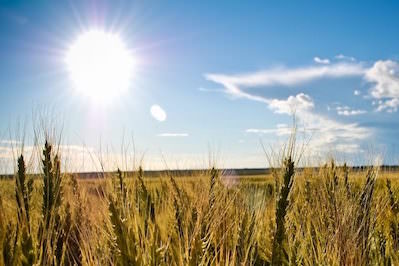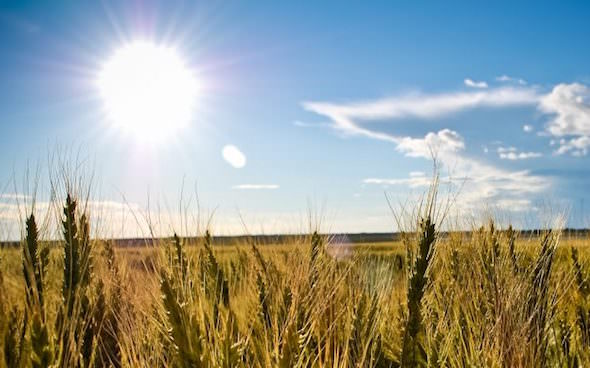The Climate Is Changing Too Quickly for Crops to Survive
New study shows grassland species can't survive such rapid temperature increases. The grass family includes wheat, corn, rice and many other plants that underwrite human survival.
By Tim Radford / Climate News Network

Although food demand is likely to rise, wheat yields in many regions could fall as the climate warms. Rick via Flickr
LONDON — Climate change is happening faster than many species can adapt to — and climate is changing between 3,000 and 20,000 times faster than many grassland species can respond.
Since the grass family includes wheat, corn, rice, sorghum, oats, rye, barley and many other plants that underwrite human survival, this is serious news.
Although the new research by scientists in the US does not directly address the future of food in a globally warming world, the researchers say their finding has “troubling” implications.
They report in the Royal Society journal Biology Letters that they concentrated their research on the family Poaceae, otherwise known as the grasses.
Creatures subjected to climatic change face only three outcomes: they can relocate uphill or nearer the poles as the temperatures rise; they can evolve to meet the new conditions; or they can go extinct.
Niche climate
So John Wiens, a professor of ecology and evolutionary biology, and colleagues from the University of Arizona looked at the options open to species that occupy a specific climatic niche.
Just as global climates can change, so can niche climates. But could they change at the same rate?
The lesson from the vertebrate world is that climate is changing 100,000 times faster than animal niches change, but vertebrates have legs or fins — so they can shift their ground.
The Arizona team looked at pairs of sister species in the grass family, selecting 236 from nine subfamilies of the grasses, representing 95 separate genera. They constructed a phylogenetic tree to see how closely related the species were, calculated their evolutionary age, and then calculated the rate of change of the niches they occupy.
They then looked at simulations for 32 possible climate scenarios for rates of projected climate change by 2070 and found that, overall, niche temperatures can vary by between 1°C and 8°C and rainfall by 200 to 600 mm in the course of a million years.
“Climate change is outpacing our ability
to adapt food production. In some areas,
urgent action is required ”
But rates of global climate change are going to be much faster — “suggesting that extinctions might occur in many species and/or local populations,” they write. “This has several troubling implications, for both global biodiversity and human welfare.”
Other scientists warned last month that climate change would affect yields in many parts of the world, with as usual the greatest cost imposed upon the poorest people. The Arizona study uses a different approach to come to the same conclusion.
Put bluntly, all flesh is grass, because all carnivores depend on herbivores and herbivores depend on grass.
Humans gain at least 49% of their calories directly from the cereals developed from wild grasses, and — since all the domesticated species have a more limited genetic inheritance than their wild ancestors — evolutionary adaptation seems unlikely. Wild varieties, too, could be endangered by climate change.
“Even local declines may be devastating for some human populations,” the Arizona scientists warn. “Strong reductions in crop yields are already predicted.”
Andrew Challinor, professor of climate impacts at University of Leeds in the UK, also called the results “troubling”.
He has already warned that climate change in Africa means that 60% of the terrain used to grow beans could become unviable by 2100. And he has separately urged plant breeders to start now adapting species to dramatically warmer conditions.
Wheat yields
Professor Challinor is one of a team of more than 60 scientists who report in Nature Climate Change journal that they tested the predicted impact of climate on global wheat yields by three independent methods to deliver much the same conclusion: with just 1°C global temperature increase, wheat yields are expected to fall by between 4.1% and 6.4%.
They divided the planet into grids and looked at climate and data for rice, maize, wheat and soybean for each grid. They looked at 30 field sites that represented two-thirds of the world’s wheat-producing areas, and then they scaled the data from these 30 “sentinel sites” to extrapolate outcomes for areas with similar conditions.
What they found, repeatedly, was that although food demand is likely to rise by at least 60%, yields in many regions could fall.
“Climate change is outpacing our ability to adapt food production,” Professor Challinor says. “In some areas, urgent action is required,
“Today’s global assessment is a wake-up call to redouble efforts to work out when and where major problems are expected.”
Tim Radford, a founding editor of Climate News Network, worked for The Guardian for 32 years, for most of that time as science editor. He has been covering climate change since 1988.
Your support matters…Independent journalism is under threat and overshadowed by heavily funded mainstream media.
You can help level the playing field. Become a member.
Your tax-deductible contribution keeps us digging beneath the headlines to give you thought-provoking, investigative reporting and analysis that unearths what's really happening- without compromise.
Give today to support our courageous, independent journalists.









You need to be a supporter to comment.
There are currently no responses to this article.
Be the first to respond.